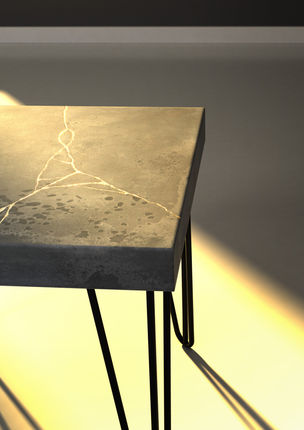Kintsugi style Accent Table
While not technically a Kintsugi table, as it was never broken, we love the look and philosophy of Kintsugi.
This is a combination of poured and sprayed glassfibre reinforced concrete (GRC / GFRC) to create a speckled effect. The “crack” texture is applied to the form before casting and then gilded once removed from the form. The whole tabletop is then sealed. Despite its perceived thickness, the GRC is cast at only 8mm thick meaning it is very light, while being super strong.
DIMS: 500x500x55 (top) 450 high
Kintsugi (金継ぎ, "golden joinery"), also known as kintsukuroi (金繕い, "golden repair"), is the Japanese art of repairing broken pottery by mending the areas of breakage with lacquer dusted or mixed with powdered gold, silver, or platinum; the method is similar to the maki-e technique.
As a philosophy, it treats breakage and repair as part of the history of an object, rather than something to disguise. Similar to the philosophy of wabi-sabi, an embracing of the flawed or imperfect. Japanese aesthetics values marks of wear from the use of an object. This can be seen as a rationale for keeping an object around even after it has broken; it can also be understood as a justification of kintsugi itself, highlighting cracks and repairs as events in the life of an object, rather than allowing its service to end at the time of its damage or breakage. The philosophy of kintsugi can also be seen as a variant of the adage, "Waste not, want not".
















